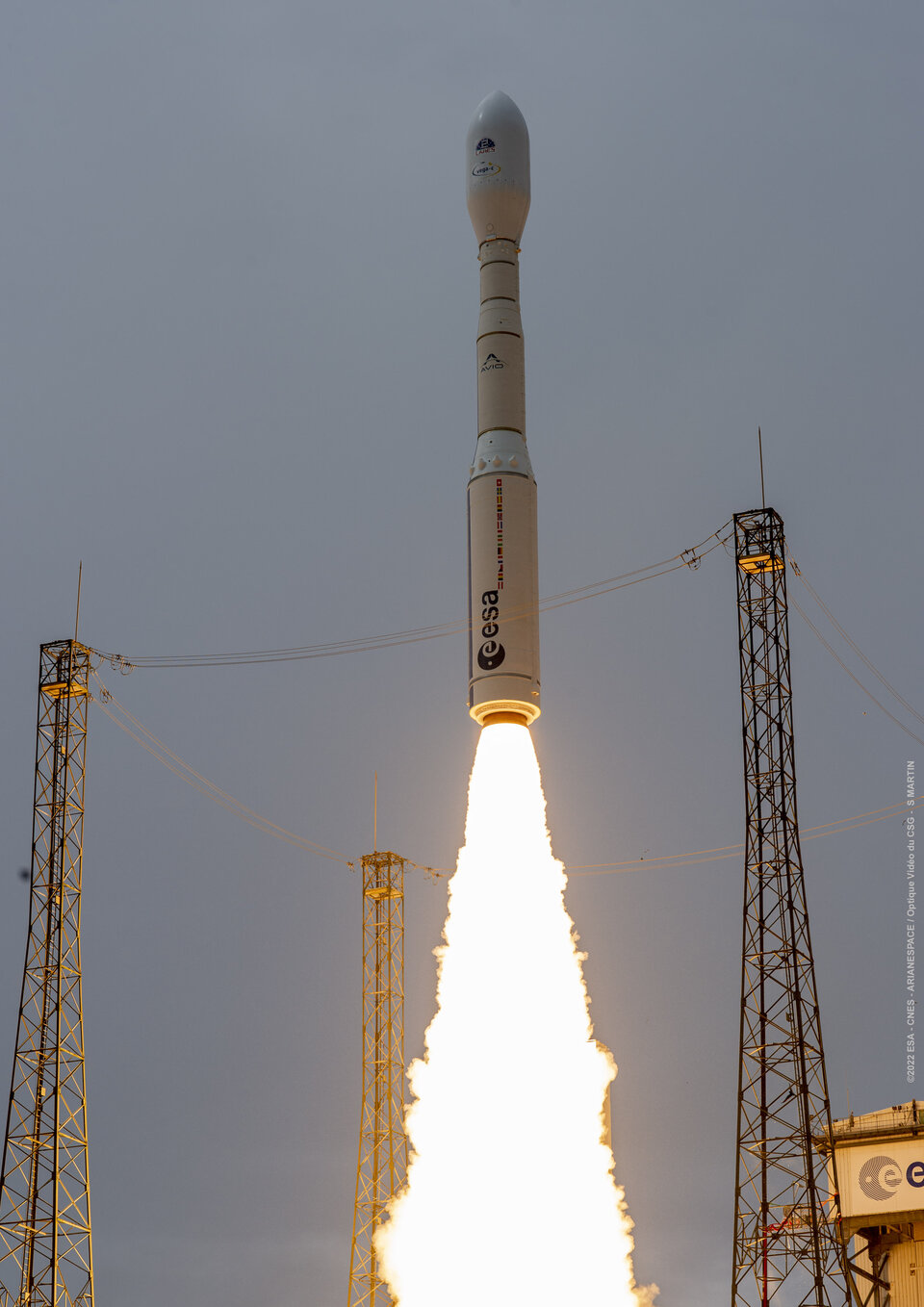Vega-C successfully completes inaugural flight
ESA’s new Vega-C rocket has completed its inaugural flight, placing main payload LARES-2 – a scientific mission of the Italian Space Agency ASI – into its planned orbit. Six research CubeSats from France, Italy and Slovenia flew as secondary payloads. The launch caps a multi-year effort by ESA, prime contractor Avio and industrial partners in 13 ESA member states to build on the heritage of its predecessor, Vega.
Flight VV21 lifted off from Europe’s Spaceport in French Guiana at 15:13 CEST/13:13 UTC on 13 July 2022 (10:13 local time). This mission lasted about 2 hours and 15 minutes from lift-off to release of final payload and final burn of the AVUM+ upper stage engine.
Total payload mass at liftoff was approximately 474kg: 296 kg for LARES-2, with the remainder being the six CubeSats, payload adapters and carrying structures.
Vega-C represents a dramatic capability boost compared to Vega, which has flown since 2012. With new first and second stages and an uprated fourth stage, Vega-C increases performance from Vega’s 1.5 t to about 2.3 t in a reference 700 km polar orbit.
Overseeing launch operations from mission control at the Spaceport, ESA Director of Space Transportation Daniel Neuenschwander remarked: “Today we open a new era of European launch solutions, starting with Vega-C and to be complemented by Ariane 6.”

Vega-C features a new, more powerful first stage, P120C, based on Vega’s P80. Atop that is a new second stage, Zefiro-40, and then the same Zefiro-9 third stage as used on Vega.
The re-ignitable upper stage is also improved. AVUM+ has increased liquid propellant capacity, to deliver payloads to multiple orbits depending on mission requirements and to allow for longer operational time in space, to enable extended missions.
The P120C motor will do double service, with either two or four units acting as strap-on boosters for Ariane 6. Sharing this component streamlines industrial efficiency and improves cost-effectiveness of both launchers.
With its larger main stages and bigger fairing – which doubles the payload volume compared to Vega – Vega-C measures 34.8 m high, nearly 5 m taller than Vega.
The new launcher configuration delivers a significant improvement in launch system flexibility. Vega-C can orbit larger satellites, two main payloads or accommodate various arrangements for rideshare missions. ESA’s upcoming Space Rider return-to-Earth vehicle will be launched to orbit on Vega-C.
The precise orbital path of LARES-2 will be tracked by laser, from ground stations. The purpose of the mission is to measure the so-called frame-dragging effect, a distortion of space-time caused by the rotation of a massive body such as Earth as predicted by Einstein’s General Theory of Relativity. Its predecessor, the similar LARES, was the main payload on the 2012 inaugural flight of Vega.
Six CubeSats made a secondary payload package. AstroBio CubeSat (Italy) will test a solution for detecting biomolecules in space. Greencube (Italy) carries an experiment to grow plants in microgravity. ALPHA (Italy) aims to help understand phenomena related to Earth’s magnetosphere, such as the Northern and Southern Lights.
Three other CubeSats – Trisat-R (Slovenia), MTCube-2 (France) and CELESTA (France) will study the effects of a harsh radiation environment on electronic systems.


Access the video
FURTHER EVOLUTION
As Vega-C begins operations, development continues. A further variant, Vega-E, will from 2026 provide a simplified architecture by replacing both the Vega-C third and fourth stages with a new cryogenic upper stage. Key to Vega-E is the Europe-built M10 engine, M10 uses more environmentally sustainable propellants – cryogenic liquid oxygen and methane – and features an advanced pressure control system that enables multiple stops and restarts in space. Prime contractor Avio recently completed its first hot-fire test series.
VV21 was operated by ESA, which owns the Vega-C programme and oversees its development. This inaugural flight paves the way for the start of exploitation by Arianespace and Avio.
Following Vega’s success, Member States at the ESA Ministerial meeting in December 2014 agreed to develop the more powerful Vega-C to respond to an evolving market and long-term institutional needs. ESA member states participating in the Vega-C programme are Austria, Belgium, the Czech Republic, France, Germany, Ireland, Italy, the Netherlands, Norway, Romania, Spain, Sweden and Switzerland.














 Germany
Germany
 Austria
Austria
 Belgium
Belgium
 Denmark
Denmark
 Spain
Spain
 Estonia
Estonia
 Finland
Finland
 France
France
 Greece
Greece
 Hungary
Hungary
 Ireland
Ireland
 Italy
Italy
 Luxembourg
Luxembourg
 Norway
Norway
 The Netherlands
The Netherlands
 Poland
Poland
 Portugal
Portugal
 Czechia
Czechia
 Romania
Romania
 United Kingdom
United Kingdom
 Slovenia
Slovenia
 Sweden
Sweden
 Switzerland
Switzerland






































